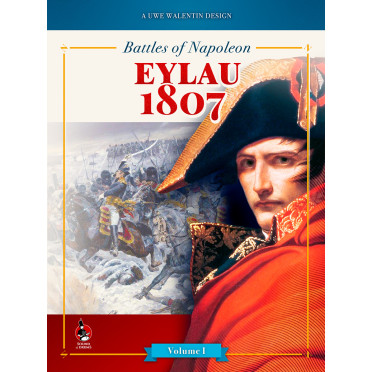Battles of Napoleon: Volume I - Eylau 1807
SOD202301
- English
- From 14 years old
- 3 to 4h, 4h and more
- 2 player(s)
Battles of Napoleon is an epic game series that simulates the most famous battles of Napoleon on a tactical scale sharing the same basic rules.
The series portrays the most important aspects of battles of the Napoleonic era with easy to learn and remember rules, intuitive mechanics and procedures. Players may focus on taking decisions and playing rather than consulting rules.
The system focusses on the “cat-and-mouse game” of coordination and timing of the various formations of the different arms without too much crunchy chrome.
Infantry was the predominant and most important element in every European army of the period. It usually formed between 60 and 90 per cent of an army in battle, and was both the cheapest and the most versatile type of troops. The foot soldiers had to endure most of the fighting and casualties. Depending on their task, they were either deployed in line (fire power), column (maneuver and assault) or square formation (protection against enemy cavalry).
Cavalry were screening the own army and provided the shock element on a Napoleonic battlefield. Due to their shock power they fixed enemy infantry and forced them to take shelter in square formation. If infantry failed to form square they were overrun. If infantry was fixed in semi-static squares they were very vulnerable to artillery fire. Artillery, the queen of the battlefield, was on the one hand having devastating effects on square and closely packed formations, on the other hand artillery alone was extremely vulnerable when getting charged by enemy units.
Generals are tasked with taking advantage of favorable terrain like the famous Duke of Wellington who mastered the reverse slope tactic.
By a simple game mechanic, players will never know the exact strength and power of an enemy unit. Units have a number of strength points that will gradually decrease while engaged with enemy units.
An innovative chit-based Command system, where players randomly draw activation chits determines which army may activate a formation, leads to highly interactive game play. Reaction follows action. We bring the chit-based Command system to a new level: In this games series, players decide which formation is activated when a chit is drawn. A formation may be activated several times per turn. But by each new activation it performs less effective.
During a game turn the players are under constant pressure to decide which formation to activate. By efficient timing of activation players are in the “driver’s seat” to dictate the pace of a battle.
Formations are given orders at the beginning of a game turn and are therefore limited by the actions they can perform on the battlefield. The more “aggressive” orders formations will receive, the more likely is the army will collapse due to fatigue. On the other hand, an army is more likely to gain the initiative on the battlefield by “aggressive” orders.
The scale of the series is appr. 150 meters per hex, infantry units are battalions, artillery is batteries and cavalry is represented as regiments. A game turn represents 60 minutes. Within a game turn a formation may be activated up to three times (with lower performance on each activation).
The bloody winter battle of EYLAU 1807 is the first volume in this series. Special rules like the possibility to launch a massive cavalry charge and features like snow storms, Russian Cossacks and the French Guard add distinctive flavor of the battle.
| Theme(s) | History, War | |
| Language(s) | English | |
| Mechanism(s) | Simulation | |
| Author(s) | Uwe Walentin | |
| Editor | Sound of Drums |
Soyez le premier à commenter ce jeu
Vous devez être identifié pour soumettre des avis.
Copyright © 2024 www.philibertnet.com Legals - Privacy Policy - Cookie Policy - Sitemap











